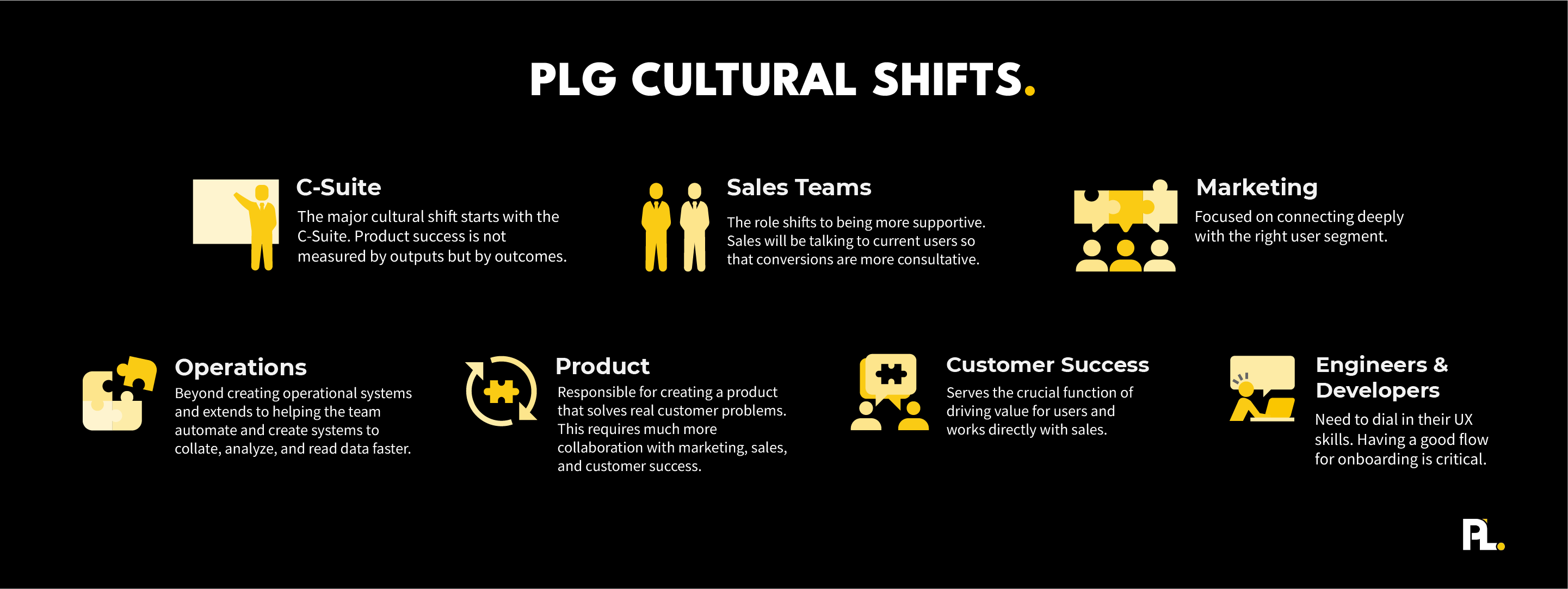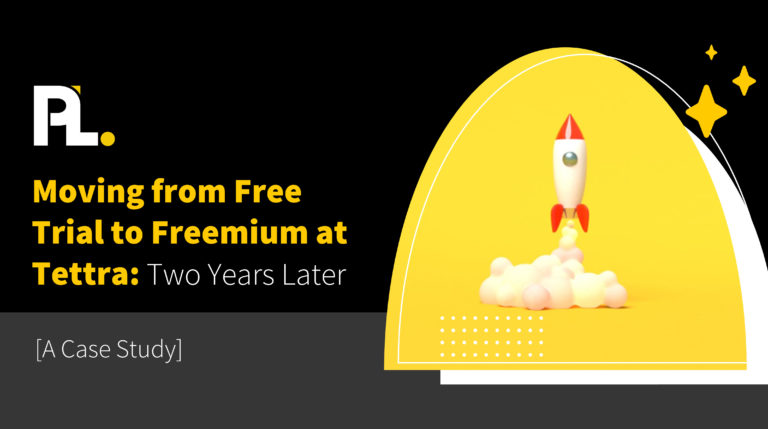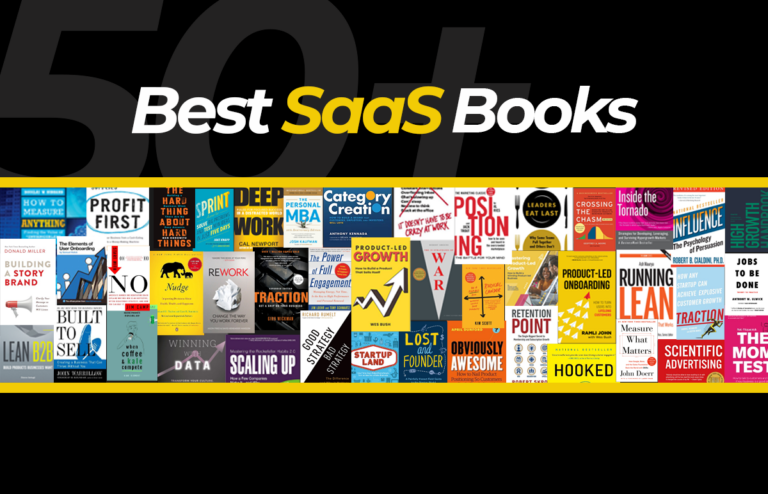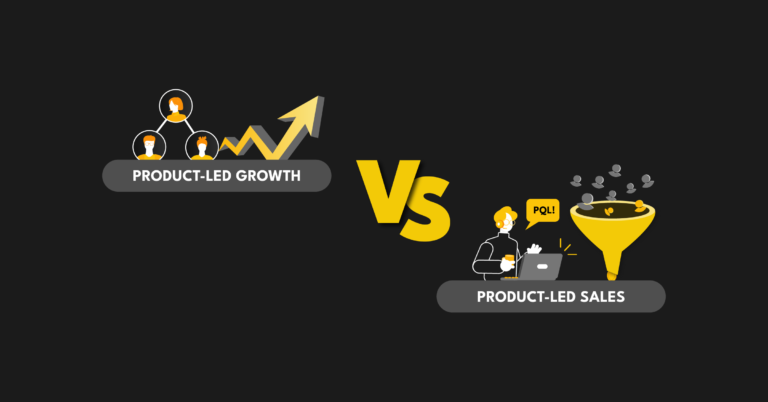Do you remember when you were a kid and did science experiments? The experiment was never about failing or winning. Instead, it was about learning scientific processes and how they relate to the natural world.
Product-led growth (PLG) is similar.
Unfortunately, the fear of failure is a major saboteur for many thought leaders and PLG teams.
In this blog, I will show you why the most important step in creating a PLG team is redefining failure and also dig into:
Then, we’ll round out the article with an overview of the shift that happens in traditional roles inside your product-led team.
How to Start Building Your PLG Team
PLG is most effective as a top-down motion. Once leadership is onboard, it's key that everyone understands the company’s North Star metric and how a product-led growth strategy aligns and brings your company closer to the overarching goal.
Understanding the set of objectives a company needs to put in motion to reach its goal will ultimately determine who should be on the team.
These objectives can be best broken down and understood through a narrative of facts.
Here’s an example.
You are a B2B company looking to capture a portion of the market. Your narrative of facts would look like this:
- There are 200,000 companies in the US.
- Our goal is to capture a percentage of these companies.
- What would have to be true to capture a percentage?
- How fast would users need to see value?
After you review the facts, your company realizes the following is true about your product and market position.
Our product:
- Runs smoother than our competitors.
- Has more useful functionality than our competitors.
- Has more integrations than our competitors.
Looking at this list. How can a product-led growth strategy help the company achieve its North Star metric?
For this particular example, getting the user into the product as fast as possible and showing them how the product works better is the key to conversions.
How does product-led growth do this?
- By eliminating unnecessary steps in the onboarding process.
- By accelerating a user's time-to-value (TTV).
- Ensuring all information is readily available and visible to assist the user as they need help.
The idea is that as the company converts users, it moves closer to its North Star capturing a percentage of the market. So make sure your first set of PLG initiatives is built around this goal.
For your first initiative, pick something that will:
- Add value
- Improve your product immediately
- Or provide insight on how to do one of these two things.
When picking your objectives or initiatives, ask yourself if the choice helps lay a foundation for predictable growth.
It Sounds Easy, But It’s Not
At first glance, this feels like a doable task. But when you put it into motion, it’s always shocking what comes out.
What I mean is you’re going to find weaknesses in your:
- Product
- Website
- And onboarding flow
To fix these weaknesses, constantly reiterate these steps:
- Discover
- Adjust
- Experiment
- Repeat
Do this repeatedly until you have a product so dialed in and an onboarding flow so smooth, Usher will write a song about it.
To achieve this, you need a team that has ownership of these movements. And this team is formed in one of two ways:
- Forming an objective-based team: Forming a small team around objectives is for companies transitioning to product-led and not wanting to hire a dedicated team to work full-time on the initiative. The team owns the movement, while the individual members maintain their roles in the company they were originally hired for.
- Forming a dedicated team: Forming a core team is for companies that start as a product-led company from day one or companies ready to double down on their product-led growth investment. A core team consists of a team of people whose only job is to drive the product-led growth strategy in a company.
It’s common for companies new to PLG to start with a small objective-based team. Then after a few wins, double down on a core team to drive the strategy harder and faster.
Do You Need an Objective-Based Team?
Companies with roots in more traditional business structures tend to prefer building small teams around objectives and individual products to start the initial self-serve motion. It feels less risky and helps them understand the potential before they go “all-in.”
Objectives are heavily influenced by the set of circumstances that surrounds them.
Common circumstances are:
- lists of facts,
- your product,
- user segment,
- and resources at hand.
Once you understand the circumstances surrounding your product and company, it’s time to decide who has the skill sets to make your self-serve motion happen.
Here’s an example of how initiatives drive who is on your team.
Let's say your goal is to reduce your user's time-to-value by 50%. If your sales cycle is six months, try chipping away a month at a time. In the end, even if you don’t achieve your goal, your product is still better, and your users still have an accelerated time-to-value.
Let's lay down the facts for this example:
- The current time-to-value (TTV) is six months.
- Industry benchmarks for similar products show a three-month TTV.
- The new goal is to cut the time-to-value to three months.
Considering what we know in this example, what are some experiments you can do now to get your users into your product faster?
- Can you create a button to get them in manually?
- Are there steps you can cut out of your onboarding process?
- Have you tested where your users are getting stuck?
Now think about who in your company has the skillsets, freedom, and enthusiasm to drive these experiments.
For most companies, this would be a:
- Customer Success Manager
- Data Scientist
- Engineer (or access to an engineer)
With this particular motion, you don’t need too many people, and you can get inspiring results with this small group working on this motion.
These sort of small wins is what helps gain confidence in the movement and motivates leadership to invest more in it.
Let's say you have your objectives, and everyone from the top down is willing to go “all in” on the PLG movement.
How do you form a team for a bigger motion?
Or a Dedicated Core Team?
Forming a core team is usually for companies that are:
- Starting out product-led.
- Transforming from sales-led to product-led and ready to go all in.
- Optimizing self-serve motions you currently have in place.
A common question we get around this topic is, “What’s the magic number?”
That’s a tricky question because each company and product is so different. While there is no magic number, we can tell you what it’s not. It’s never one person. One person cannot lead the motion. PLG works best when working as a cross-functional team to drive results.
These cross-functional teams will vary depending on whether you are a small to medium company or an enterprise.
Here’s how.
Small to Medium Companies
In these cases, resources are typically scarcer. Does that mean you shouldn’t start the motion?
No.
If there’s no product market fit, there’s nothing to grow. But if you have a product-market fit, it’s time to bring in the growth team to blow….it…UP.
When forming a team, the bare minimum would be a:
- Growth Manager: Laying down a foundation for predictable growth.
- Data scientist: Managing all the data from the experiments.
- Designer: focused on the solution side, not the high-fidelity design.
- Engineer (or access to an engineer): To run the experiments
If you don’t have these resources internally, you can always outsource.
This is your basic core team that will allow you to run the process of:
- Researching
- Improving
- Launching solutions
- Testing them
- Reiterating
Remember when Zoom first launched? It was a really ugly product.
But at that point in the game, the team wasn’t worried about the aesthetics but rather the functionality of their product.
Large to Enterprise Companies
The biggest challenge for a medium-to-large company is the communication component. Departments tend to be siloed, and getting anything done takes a long time.
Product-led growth is all about being agile and quick. Typically internal processes of larger companies tend to sabotage quick and agile motions and stifle the creativity that follows leads based on outcomes.
This is why larger companies work best by forming a trusted internal team free from the burden of internal processes that hinder their ability to experiment, adjust and reiterate. Give your team the space to be creative and have them focus on a series of small wins that continuously improve the onboarding, product, and support.
For example, if you have to report your list of experiments you will conduct over the next three months, you aren’t doing it right.
Each experiment should segway into the next one. So make sure you put people in place that you trust and give them the space they need to succeed.
The special sauce for a core PLG group for a large company is similar to a small business…
- Growth Manager: Laying down a foundation for predictable growth.
- Data scientist: Managing all the data from the experiments.
- Designer: focused on the solution side, not the high-fidelity design.
- Engineer (or access to an engineer): To run the experiments.
…but has some extra players.
- Marketing: Uses insights from the Growth Manager to create a marketing channel built around the experience.
- Product Manager: Works with Marketing to optimize the experience and build a relevant acquisition and retention channel.
- Customer Success Manager: Understanding where users are dropping off and collaborating with Growth to see where people are dropping off.
- Sales: If you have a high-touch product, Sales will take on a support role and work directly with Customer Success to blast user obstacles with a human touch.
Understanding Shifts in Traditional Roles
When creating your strategy, it’s vital to create accountability for each area of focus and align it with how ownership is currently divided up within a company.
For example, who owns onboarding?
- At Drift, it's the Product Team that champions user onboarding.
- At Jungle Scout, it’s the Customer Success Team.
- At Sprout Social, it’s the Marketing Team.
- At Facebook, it’s the Growth Team.
Considering the current culture of your company, who owns what? Use the answer to assign these focuses to your team members, considering their roles.
To be successful, a company’s entire mindset needs to shift. Gaining trust in the motion takes time, and it’s important to consider how traditional roles will need to shift to realize objectives.
Here are the main ways product-led growth challenges traditional roles.
- C-Suite: The major cultural shift starts with the C-Suite. Product success is not measured by outputs but by outcomes.
- Sales teams: The role shifts to being more supportive. Sales will be talking to current users so that conversions are more consultative.
- Marketing: Focused on connecting deeply with the right user segment.
- Operations: In PLG, it’s beyond creating operational systems and extends to helping the team automate and create systems to collate, analyze, and read data faster.
- Product: Responsible for creating a product that solves real customer problems-this requires much more collaboration with marketing, sales, and customer success.
- Customer Success: Serves the crucial function of driving value for users and works directly with sales.
- Engineers & Developers: Need to dial in their UX skills. Having a good flow for onboarding is critical.

There will be overlaps for smaller teams and start-ups, but for most organizations beyond the start-up phase, traditional role shifts and their areas will look like the list above.
How It Affects Budgets
Pursuing a PLG movement will affect departmental budgets. It’s important to embrace that from the beginning so department heads aren’t ambushed with budget cuts they didn’t anticipate.
For example, the Chief Marketing Officer (CMO) may not have the same marketing budget to generate advertising leads next year, or the Chief Technology Officer (CTO) won’t have the budget to hire new engineers.
Communicating what’s needed helps create a conscious decision around investing in a PLG movement. Then as a company, decide on the first initiative to get you closer to your North Star or goal.
Conclusion
As you can see, who you should have on your team depends on the size of your company, product, and user segments.
To make this strategy work, the best results come from product labs where teams are not bogged down by time-consuming processes that don’t give them the freedom to be agile, quick, and experiment as needed.
Product-led growth is a marathon, not a sprint. Most companies won’t start seeing results until the end of quarter three or four, and that’s normal. While the process takes time, your team will not only be consistently improving your product and onboarding flow but laying down the framework for predictable growth.












